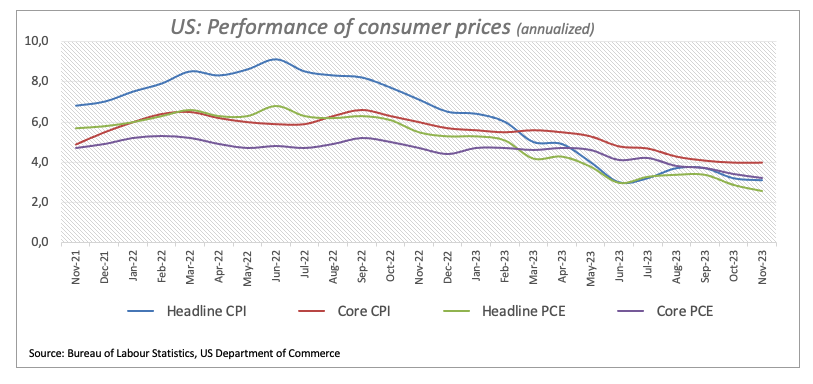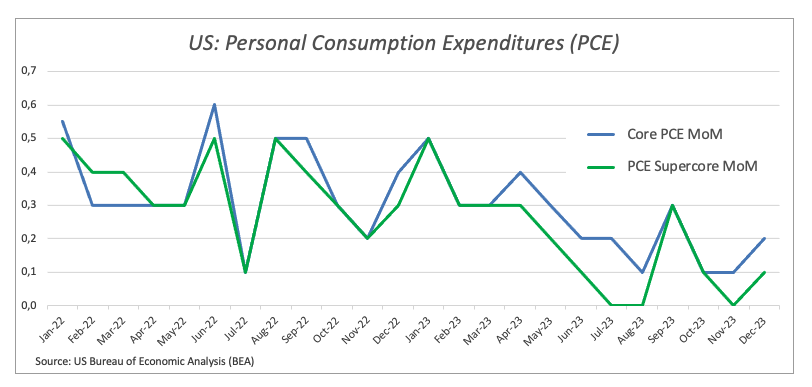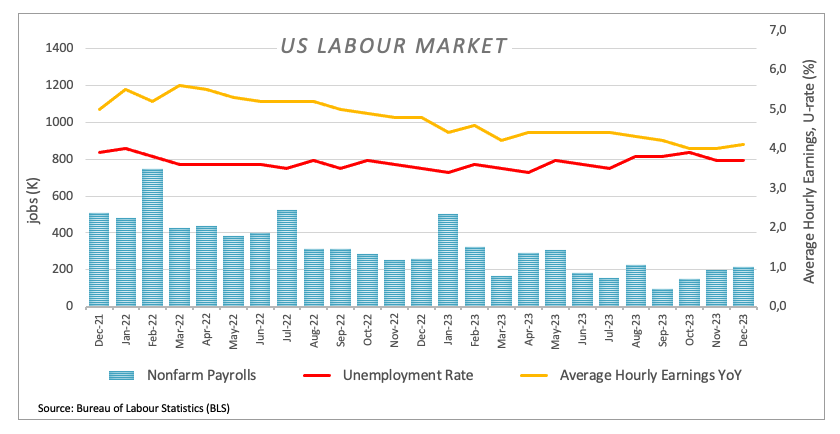Federal Reserve Chairman Jerome Powell explains the decision to leave the policy rate, federal funds rate, unchanged at the range of 5.25-5.5% and responds to questions in the post-meeting press conference.
Follow our live coverage of the Fed's monetary policy announcements and the market reaction.
Fed meeting press conference key quotes
"Risks to achieving goals are moving into better balance."
"Activity in housing sector is subdued."
"Labor market remains tight."
"Job gains are still strong, labor demand still exceeds supply."
"Inflation has eased notably, remains above goal."
"Lower inflation readings are welcome but we need to see continuing evidence to have confidece returning to target."
"Our restrictive stance is putting downward pressure on economic activity and inflation."
"Our policy rate is likely at its peak."
"Will likely be appropriate to begin reducing rates sometime this year."
"If economy evolves as expected, we will dial back policy rate this year."
"Economic outlook though is uncertain, ongoing progress on inflation is not assured."
"Prepared to maintain current policy rate for longer if needed."
"Almost everyone on the Committee believes it will be appropriate to reduce rates."
"We are trying to identify a place we are confident on inflation to begin the process of dialing back the restrictive level."
"If we saw unexpected weakening in the labor market, that would make us cut rates sooner."
"In the base case, where the economy is healthy with a strong labor market, we can be careful as we think about rate cut timing."
"There was no proposal to cut rates today."
"Based on the meeting today, I don't think likely we will have a rate cut in March."
"That's to be seen but I don't think we'll have enough confidence."
This section below was published at 19:00 GMT to cover the Federal Reserve's policy announcements and the immediate market reaction.
The US Federal Reserve (Fed) announced on Wednesday that it left the policy rate, federal funds rate, unchanged at the range of 5.25%-5.5% following the January policy meeting. This decision came in line with the market expectation.
In its policy statement, the Fed said that it does not expect it will be appropriate to reduce rates until there is greater confidence inflation is moving sustainably toward 2%.
Fed policy statement key takeaways
"Risks to achieving employment and inflation goals are moving into better balance."
"Economic outlook is uncertain, Committee remains highly attentive to inflation risk."
"Recent data suggest economic activity has been expanding at solid pace."
"Jobs gains have moderated but remain strong, unemployment remains low, inflation has eased but remains elevated."
"Bond holding reductions will continue as described previously."
"Vote in favor of policy was unanimous."
Market reaction to Fed policy decisions
The US Dollar Index edged higher toward 103.50 and erased its daily losses with the immediate reaction.
US Dollar price today
The table below shows the percentage change of US Dollar (USD) against listed major currencies today. US Dollar was the strongest against the Australian Dollar.
| USD | EUR | GBP | CAD | AUD | JPY | NZD | CHF | |
| USD | 0.10% | -0.04% | -0.02% | 0.24% | -0.42% | -0.01% | -0.05% | |
| EUR | -0.10% | -0.15% | -0.11% | 0.16% | -0.52% | -0.11% | -0.14% | |
| GBP | 0.05% | 0.17% | -0.01% | 0.22% | -0.44% | 0.03% | 0.00% | |
| CAD | 0.01% | 0.13% | -0.05% | 0.26% | -0.41% | 0.04% | 0.01% | |
| AUD | -0.21% | -0.04% | -0.21% | -0.22% | -0.67% | -0.19% | -0.24% | |
| JPY | 0.44% | 0.53% | 0.37% | 0.44% | 0.70% | 0.40% | 0.39% | |
| NZD | -0.03% | 0.10% | -0.08% | -0.04% | 0.21% | -0.45% | -0.07% | |
| CHF | 0.06% | 0.18% | 0.00% | 0.04% | 0.22% | -0.44% | 0.03% |
The heat map shows percentage changes of major currencies against each other. The base currency is picked from the left column, while the quote currency is picked from the top row. For example, if you pick the Euro from the left column and move along the horizontal line to the Japanese Yen, the percentage change displayed in the box will represent EUR (base)/JPY (quote).
This section below was published as a preview of the Federal Reserve (Fed) policy announcements at 11:00 GMT.
- The Federal Reserve is widely anticipated to keep interest rates unchanged.
- Fed Chairman Jerome Powell could shed further details on upcoming rate cuts.
- The US Dollar could find extra legs in case of a hawkish outcome.
The Federal Reserve (Fed) will announce the first monetary policy of 2024 on Wednesday, and market participants largely expect the Committee to leave the Fed Funds Target Range unchanged at 5.25%–5.50%. If consensus materializes, the January 31 meeting will be the fourth consecutive meeting the bank has kept its interest rates at the highest level in over two decades.
At his latest post-FOMC press conference, Federal Reserve Chair Jerome Powell refrained from giving specific guidance on the timing and pace of rate cuts. However, he emphasized that the Fed would need to implement rate cuts well in advance of annual inflation rates reaching their 2% target. Waiting until the target is achieved could have negative consequences for the economy due to the delayed impact of monetary policy. Additionally, Chair Powell expressed concerns about keeping rates too high for an extended period, as this could potentially hinder economic growth.
In light of the upcoming event, Senior Economist Tom Kenny and Economist Arindam Chakraborty at ANZ comment they continue to adhere to their recent advice that they believe a rate cut around the middle of the year would be fitting, but they must also be receptive to the idea of implementing rate reductions earlier. Monetary policy is no longer following a predetermined path, and the Fed must navigate the delicate balance of achieving sustained inflation at the target while avoiding a rapid increase in real interest rates, which could pose a risk of a sharp economic downturn.
Although there is now a debate among market participants regarding a potential interest rate cut in March or May, it appears that the decision to keep rates unchanged at the January 31 meeting appears to be a “done deal”. According to the FedWatch Tool measured by CME Group, the probability of an interest rate reduction in March surpasses 46% vs. nearly 52% of the same outcome at the May 1 gathering.
Anticipating the Federal Reserve's Outlook: What Lies Ahead?
Having commenced its tightening efforts in the beginning of 2022, the Fed has executed a total of 525 bps of increases to interest rates and diminished its security holdings by more than $1 trillion. Although these measures have had an impact on the economy, according to Powell, their full effects have not yet materialized. Consequently, determining the duration of the required restrictive policy and the timing for initiating cuts is currently challenging.
In the December Summary of Economic Projections (SEP), it has been revealed that the median member of the Federal Open Market Committee (FOMC) now expects a total of 75 basis points of interest rate cuts in 2024. This represents an increase of 25 basis points compared to the projections made during the September meeting. This adjustment in rate expectations may potentially be attributed to a slight downward revision in the Federal Reserve's inflation forecasts. The "dot plot" reveals a forecast of four additional interest rate cuts in 2025, totaling a decrease of one percentage point. Furthermore, three more reductions are projected for 2026, which would bring the fed funds rate to a range of 2% to 2.25%, aligning it closely with the long-term outlook.
Earlier this month, FOMC Governor Chris Waller stated that the timing of interest rate cuts in the current year would depend on discussions within the Federal Reserve policy-setting panel. He emphasized his preference to delay rate cuts until the Fed is "reasonably convinced" that inflation consistently reaches the target of 2%.
Similarly, Raphael Bostic, the Atlanta Fed's counterpart, expressed his willingness to consider implementing interest rate reductions before July if there is "compelling" evidence of inflation slowing down more rapidly than initially expected. While reaffirming the plan to begin rate cuts in the third quarter, he stressed the importance of exercising caution to prevent premature reductions that could reignite demand and inflationary pressures.
Regarding inflation, Fed officials anticipated a decline in core inflation to reach 3.2% in 2023 (it actually ended the year at 2.9%), dropping to 2.4% in 2024 and then to 2.2% in 2025. Eventually, the expectation is for it to return to the 2% target by the year 2026.
When it comes to inflation tracked by the PCE, the Committee revised its inflation forecast downward at 2.8% for 2023 (the official data eventually came out at 2.6% for December), then 2.4% in 2024, 2.1% in 2025, and 2.0% in 2026.
When will the Fed announce policy decisions and how could they affect EUR/USD?
The Federal Reserve is scheduled to announce its decision and publish the monetary policy statement at 19:00 GMT. This will be followed by Chairman Jerome Powell's press conference at 19:30 GMT. There won’t be an updated dots plot this time.
While it is widely expected that policymakers will maintain the current interest rates at 5.25%, market participants will closely scrutinize Chair Jerome Powell's remarks for any hints regarding the timing of potential rate cuts, especially given the recent decrease in expectations for rate cuts in March.
As the Federal Reserve gets ready for its first meeting of a new year, its challenges look different from those from, say, a year ago. By this time, disinflationary pressures appear to be running firm against the backdrop of higher interest rates, diminishing energy costs and a still pretty tight labor market, all amidst a healthy resilience of the US economy.
Recent strong US fundamentals have reinforced the view above, paving the way for an increasingly likely “soft landing”. On this, Chair Powell is expected to keep a cautious tone and emphasize that there is still work to be done regarding inflation, while keeping the Fed’s data-dependent stance intact.
Other than that, investors should be closely monitoring any signs from Powell regarding the timing of the potential start of an easing cycle
Pablo Piovano, Senior Analyst at FXStreet, notes: “The USD Index (DXY) seems to have embarked on a consolidative phase around the 103.50 zone in the last couple of weeks, in quite a vigilant stance ahead of imminent key events. Around this area also coincides with the critical 200-day SMA. The surpassing of this region could open the door to further gains in the short-term, with an interim target at the 100-day SMA around 104.30, where the December 2023 highs also sit. On the downside, a rapid loss of momentum should not see any contention of significance until the December 2023 low in the 100.60 zone.”
Regarding EUR/USD, Piovano adds: “EUR/USD has kicked off the new trading year well on the defensive, uninterruptedly shedding more than three cents since late December peaks near 1.1140 amidst the resurgence of a strong bid bias in the US Dollar. The loss of the so-far 2024 low around 1.0795 could expose extra weakness to the December low at 1.0723. In case of bouts of strength, the pair should need to subsequently clear the 55-day SMA around 1.0910, seconded by the weekly top around the psychological 1.1000 barrier just to refocus on the December high near 1.1140.
Finally, Piovano suggests that a sustained decline below the critical 200-day SMA in the 1.0840 area should shift the pair’s outlook to the downside, which would allow for a deeper decline initially to the December 2023 low at 1.0723 (December 8). Further losses from here should require an important worsening of the EUR’s outlook, which appears to be unlikely for the time being.”
Interest rates FAQs
What are interest rates?
Interest rates are charged by financial institutions on loans to borrowers and are paid as interest to savers and depositors. They are influenced by base lending rates, which are set by central banks in response to changes in the economy. Central banks normally have a mandate to ensure price stability, which in most cases means targeting a core inflation rate of around 2%.
If inflation falls below target the central bank may cut base lending rates, with a view to stimulating lending and boosting the economy. If inflation rises substantially above 2% it normally results in the central bank raising base lending rates in an attempt to lower inflation.
How do interest rates impact currencies?
Higher interest rates generally help strengthen a country’s currency as they make it a more attractive place for global investors to park their money.
How do interest rates influence the price of Gold?
Higher interest rates overall weigh on the price of Gold because they increase the opportunity cost of holding Gold instead of investing in an interest-bearing asset or placing cash in the bank.
If interest rates are high that usually pushes up the price of the US Dollar (USD), and since Gold is priced in Dollars, this has the effect of lowering the price of Gold.
What is the Fed Funds rate?
The Fed funds rate is the overnight rate at which US banks lend to each other. It is the oft-quoted headline rate set by the Federal Reserve at its FOMC meetings. It is set as a range, for example 4.75%-5.00%, though the upper limit (in that case 5.00%) is the quoted figure.
Market expectations for future Fed funds rate are tracked by the CME FedWatch tool, which shapes how many financial markets behave in anticipation of future Federal Reserve monetary policy decisions.
Information on these pages contains forward-looking statements that involve risks and uncertainties. Markets and instruments profiled on this page are for informational purposes only and should not in any way come across as a recommendation to buy or sell in these assets. You should do your own thorough research before making any investment decisions. FXStreet does not in any way guarantee that this information is free from mistakes, errors, or material misstatements. It also does not guarantee that this information is of a timely nature. Investing in Open Markets involves a great deal of risk, including the loss of all or a portion of your investment, as well as emotional distress. All risks, losses and costs associated with investing, including total loss of principal, are your responsibility. The views and opinions expressed in this article are those of the authors and do not necessarily reflect the official policy or position of FXStreet nor its advertisers. The author will not be held responsible for information that is found at the end of links posted on this page.
If not otherwise explicitly mentioned in the body of the article, at the time of writing, the author has no position in any stock mentioned in this article and no business relationship with any company mentioned. The author has not received compensation for writing this article, other than from FXStreet.
FXStreet and the author do not provide personalized recommendations. The author makes no representations as to the accuracy, completeness, or suitability of this information. FXStreet and the author will not be liable for any errors, omissions or any losses, injuries or damages arising from this information and its display or use. Errors and omissions excepted.
The author and FXStreet are not registered investment advisors and nothing in this article is intended to be investment advice.
Recommended content
Editors’ Picks
EUR/USD stays in positive territory above 1.0850 after US data

EUR/USD clings to modest daily gains above 1.0850 in the second half of the day on Friday. The improving risk mood makes it difficult for the US Dollar to hold its ground after PCE inflation data, helping the pair edge higher ahead of the weekend.
GBP/USD stabilizes above 1.2850 as risk mood improves

GBP/USD maintains recovery momentum and fluctuates above 1.2850 in the American session on Friday. The positive shift seen in risk mood doesn't allow the US Dollar to preserve its strength and supports the pair.
Gold rebounds above $2,380 as US yields stretch lower

Following a quiet European session, Gold gathers bullish momentum and trades decisively higher on the day above $2,380. The benchmark 10-year US Treasury bond yield loses more than 1% on the day after US PCE inflation data, fuelling XAU/USD's upside.
Avalanche price sets for a rally following retest of key support level

Avalanche (AVAX) price bounced off the $26.34 support level to trade at $27.95 as of Friday. Growing on-chain development activity indicates a potential bullish move in the coming days.
The election, Trump's Dollar policy, and the future of the Yen

After an assassination attempt on former President Donald Trump and drop out of President Biden, Kamala Harris has been endorsed as the Democratic candidate to compete against Trump in the upcoming November US presidential election.


